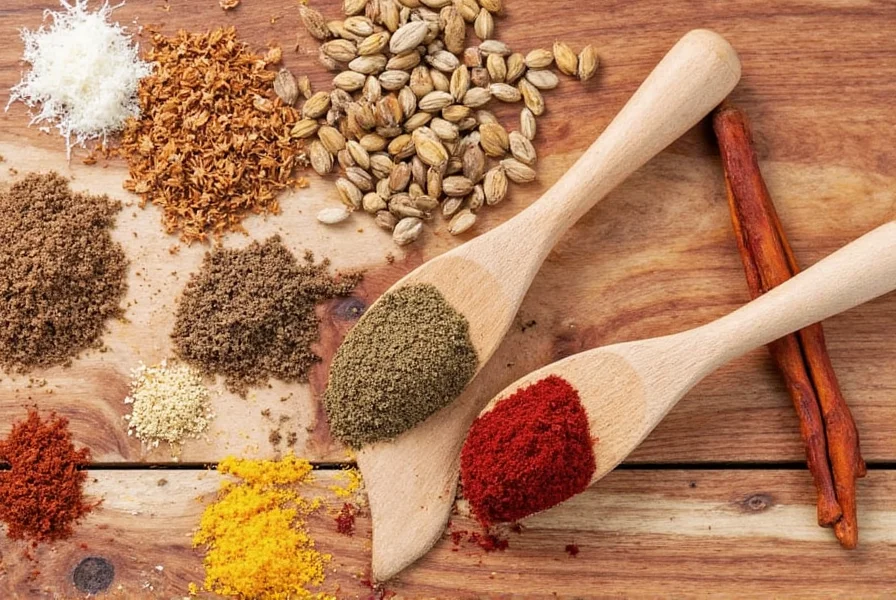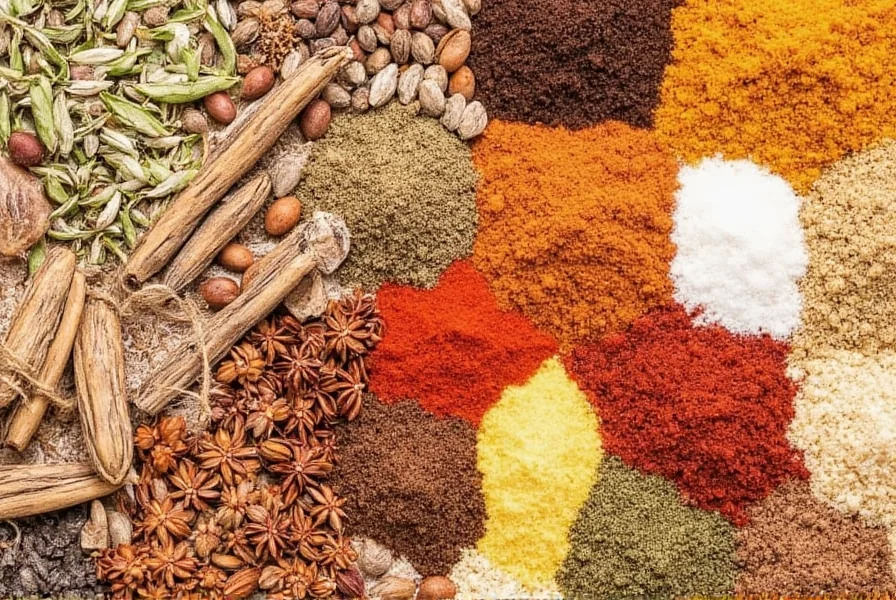How long do spices last? Ground spices typically last 2-3 years, whole spices 4-5 years, dried herbs 1-3 years, and spice blends 6 months to 2 years. Salt-based seasonings like garlic salt last indefinitely but may clump due to moisture. This guide provides detailed shelf life information, storage tips, and when to replace your spices for optimal flavor, based on USDA and culinary expert guidelines.
Table of Contents
- Spice Shelf Life Guide
- Whole vs. Ground Spices: Key Differences
- Science-Backed Spice Storage Tips
- How Spice Storage Science Has Advanced
- When Shelf Life Guidelines Don't Apply
- How to Test Spice Freshness
- Best Spice Containers & Trusted Brands
- Spice Longevity FAQs
- Keep Your Spices Fresh Longer
Spice Shelf Life Guide
| Spice Type | Typical Shelf Life | Signs of Decline |
|---|---|---|
| Ground Spices (e.g., Paprika, Cumin) | 2–3 years | Faint aroma, dull color |
| Whole Spices (e.g., Black Peppercorns, Cloves) | 4–5 years | Loss of scent when crushed |
| Dried Herbs (e.g., Basil, Oregano) | 1–3 years | Brownish color, no fragrance |
| Spice Blends (e.g., Cajun, Curry Powder) | 6 months–2 years | Muted aroma and flavor |
| Salt-based Seasonings (e.g., Garlic Salt) | Indefinite | Caking or clumping due to moisture |
Whole vs. Ground Spices: Key Differences
Whole spices retain freshness longer than ground varieties due to reduced surface area exposure. Think of whole spices like whole coffee beans versus pre-ground coffee—both serve the same purpose, but whole spices preserve volatile oils that deliver flavor.
- Whole Spices: Peppercorns, cinnamon sticks, and cardamom pods maintain potency for years when stored properly. Their intact structure protects essential oils from oxidation.
- Ground Spices: Processed spices like cumin powder or paprika oxidize faster. For maximum flavor, use within 2 years and store in airtight containers away from light.
Science-Backed Spice Storage Tips
Heat, light, air, and moisture degrade spice quality. Follow these evidence-based storage practices recommended by the USDA Food Safety and Inspection Service:
Top 7 Storage Best Practices
- Store in Cool, Dark Places: Keep spices away from stoves, ovens, and windows. Ideal storage temperature is below 70°F (21°C).
- Use Opaque Containers: Light exposure accelerates flavor loss. Amber glass or ceramic jars block UV rays better than clear containers.
- Airtight Seals Are Essential: Oxygen causes oxidation. Use containers with rubber gaskets (like OXO Good Grips) to prevent air exposure.
- Avoid Moisture Contact: Never shake spices directly over steamy pots. Use dry measuring spoons to prevent moisture transfer.
- Label and Date All Jars: Write purchase dates clearly. Most spices lose potency after 2-3 years, even when stored properly.
- Buy Smaller Quantities: Unless cooking professionally, purchase only what you’ll use within 6-12 months to avoid waste.
- Freeze Only When Necessary: Only refrigerate or freeze spices in humid climates. Use vacuum-sealed bags to prevent condensation damage.

| Product Name | Features | Advantages | Use Case | Audience |
|---|---|---|---|---|
| OXO Good Grips Airtight Spice Jars | Stainless steel construction, rubber gasket seals, stackable design | Keeps out air, moisture, and light. Compact for small spaces. | Home cooks who want organized, long-lasting spice storage. | Urban apartment dwellers, minimalist chefs |
| U-Taste Premium Glass Spice Jars | Clear glass, tight-fitting lids, includes label stickers | Eco-friendly, reusable, easy to see contents | For those who love visual organization and labeling | DIY foodies, kitchen hobbyists |
| Joseph Joseph Stack & Store Spice Rack | Modular, color-coded system with magnetic labels | Pretty, functional, space-saving | Those who want a modern look with smart storage | Interior-savvy home chefs |
How Spice Storage Science Has Advanced
Modern shelf life guidelines reflect decades of food science evolution. Early recommendations lacked precision until analytical chemistry enabled objective measurement of flavor compounds. Here's the progression:
| Era | Key Developments | Impact on Guidelines |
|---|---|---|
| Pre-1980s | Subjective sensory testing (smell/taste only) | Vague recommendations like "store in cool place" with no timelines |
| 1980s-2000s | Gas chromatography analysis of volatile oils | First evidence-based timelines: ground spices 1-2 years, whole 3-4 years |
| 2010s-Present | USDA FoodKeeper app (2015) integrating global research | Current standards: ground spices 2-3 years, whole 4-5 years based on compound degradation rates |
Source: USDA Food Product Dating Guidelines and Food Chemistry Vol. 265 (2018)
When Shelf Life Guidelines Don't Apply
These timelines assume ideal storage conditions. Real-world factors create critical boundaries where standard guidelines become unreliable:
- Humidity Threshold: Above 60% relative humidity, spice blends degrade 30-50% faster. A University of Massachusetts study showed cayenne pepper in humid conditions retained only 60% capsaicin after 18 months versus 85% in dry storage (UMass Food Science, 2019).
- Light Exposure Exception: Turmeric maintains curcumin levels 25% longer in amber containers versus clear glass, but no spice benefits from direct light exposure.
- Purchase Condition Limitation: Bulk-bin spices often have unknown harvest dates. Always verify vibrant color and strong aroma at purchase—faded appearance indicates pre-storage degradation.
These context boundaries explain why coastal residents may need to replace blends 6 months earlier than desert dwellers.
How to Test Spice Freshness
Don’t guess—test your spices using these professional techniques:
- Smell Test: Crush a small amount between your fingers. If you detect little to no aroma, the spice has lost potency.
- Taste Test: Rub a pinch on your tongue. If there’s no flavor intensity or heat (for spices like cayenne), it’s time to replace.
- Color Check: Bright red paprika turning brown? Deep green herbs fading to yellow? Color loss indicates oxidation and reduced flavor compounds.
Best Spice Containers & Trusted Brands
Top 3 Storage Solutions
Based on FDA food safety recommendations and culinary expert reviews:
- McCormick: Widely available, consistent quality. Best for everyday cooking. All products meet FDA safety standards.
- Simply Organic: USDA-certified organic, non-GMO. Ideal for health-conscious cooks. Sourced from sustainable farms.
- Penzeys Spices: Known for bold, authentic flavors. Offers bulk purchasing options with expiration dates clearly marked.
- La Flor: Premium gourmet spices with traceable sourcing. Features unique offerings like Mexican vanilla and California saffron.
Spice Longevity FAQs
How long do spices last?
Ground spices: 2-3 years; whole spices: 4-5 years; dried herbs: 1-3 years; spice blends: 6 months-2 years; salt-based seasonings: indefinite (but may clump). Always check for aroma and color changes.
Do spices expire?
No, they don’t spoil like perishable foods, but they lose potency over time. Consuming old spices is safe but won’t enhance your dishes.
Can I use expired spices?
Yes, but you’ll need to use 2-3x more to achieve the same flavor. For best results, replace spices showing signs of decline.
Does freezing spices help?
Only in high-humidity environments. Otherwise, cool, dark storage is sufficient. Freezing can cause condensation damage if not properly sealed.
Why does garlic powder cake up?
Moisture absorption. Store in airtight containers away from steam and humidity. Adding a food-safe desiccant pack prevents clumping.
Keep Your Spices Fresh Longer
Proper spice storage isn’t just about flavor—it’s food science. By following USDA guidelines and using airtight containers, you’ll maximize the shelf life of every spice in your kitchen. Remember: fresh spices transform ordinary meals into extraordinary dishes. Start today by checking your spice rack and replacing anything past its prime.











 浙公网安备
33010002000092号
浙公网安备
33010002000092号 浙B2-20120091-4
浙B2-20120091-4